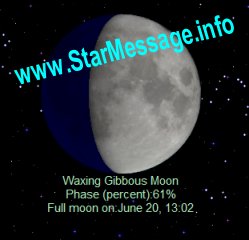Full Moon, Moon phase of Saturday, November 16th, 2024
Primary tabs
Follow the moon phases with our StarMessage screensaver.

If you like the moon, you should get its screensaver.
A full moon always rises in the east around the time the sun is setting in the west. At full moon, we are seeing all of the moon's day side. The moon and sun are on a line, with Earth in between. It's as though Earth is the fulcrum of a seesaw, and the moon and sun are sitting on either end of the seesaw. Thus as the sun sets in the west, the full moon rises. When the sun is below our feet at midnight, the full moon is highest in the sky. When the sun rises again at dawn, the full moon is setting.
In many ways, a full moon is the opposite of a new moon. At both the new and full phases, the moon is on a line with the Earth and sun. At new moon, the moon is in the middle position along the line. At full moon, Earth is in the middle.
Full moon always comes about two weeks after new moon, when the moon is midway around in its orbit of Earth, as measured from one new moon to the next.
If there is a lunar eclipse, it must happen at full moon. It's only a full moon that Earth's shadow, extending opposite the sun, can fall on the moon's face.
Read more at EarthSky.org
